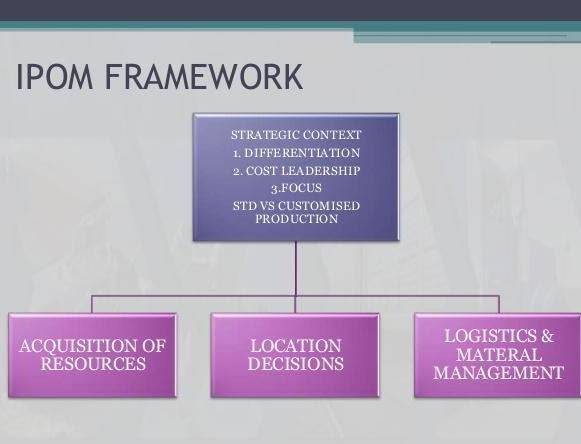
8 minute read
5 International Production and Operations Management IPOM
Corporate Angle
Mr. Nissan Vatsa
Advertisement
Assistant Manager at Saint-Gobain

Introduction
International production and operations management deals with production of goods and services in international locations and markets. It involves management process which has to take into consideration local production market (labor and capital) and international customer requirements.
Nature of IPOM
The foundation for international production and operations is no different to domestic production and operations management. But there are certain aspects which make international exposure a challenge for an organization. The very 1st difference is international business environment where not just economics but also international quality standards have to be maintained. The 2nd aspect is the international stint makes the company more aware of its surroundings thus making it more competitive. As IPOM is dynamic in nature, organization has to design it strategic objectives which cover following points: • Meeting international quality standards • Forecasting demand and production design • Profitability • Minimum production cost • Adaptation to modern available technology

Domestic POM and IPOM
Organization has to clearly identify challenges it is likely to face in an international environment. Those challenges can be categorized as follows: Culture: Domestic POM has to content with homogenous culture where as IPOM has to content with multi-culture multi-ethnicity scenario. Business Environment: Domestic POM has to consider local economical and social factors whereas IPOM has to deal with economical and social factors across geography and countries. Quality Standards: Domestic POM has to look at single local market therefore not much variation in quality standards whereas IPOM has to consider different international markets with different quality standard requirements. Pricing: Pricing for Domestic POM may not be a challenge as competition would also operate in the same environment. IPOM has to consider the customer paying capacity which may vary from developed country to developing country. Technology: In domestic environment innovation and usage of technology is much more comparable among competition. For IPOM owing to different quality and pricing requirements investment in technology becomes important.
Economies of Scale: Domestic POM has to deal with limited local market, hence limiting scope of economies of scale whereas IPOM has to access to larger market thus providing a change of achieving larger economies of scale. Market Segmentation: Domestic POM is around local market where as IPOM has to developed and diversified market.
Usage of resources: Domestic POM has to deal with in-flexibility of moving around of resources within one location while IPOM has advantage of moving around of resources from high-cost market to low-cost market.
IPOM Strategies
Organization needs to consider the following point while developing IPOM strategies: Production/Factory Location: The choice of location for the production facility depends on its proximity near to the market and cost of production (labor) in that particular environment. Factory design, layout and quality standards: Organization need to standardize design and layout across their production location as to minimize production planning process, provide flexibility in sharing technical knowledge and manpower. External vendor and procurement: Organization needs to finalize the vendors to provide raw material as well important components required to complete the final product. Also, procurement schedule has to be finalized as not to hurt production.
About the Author:
Mr. Nissan Vatsa
He is currently working with Saint-Gobain as an Assistant Manager with an experience of 7 years overall in construction and building materials.
Corporate Angle
Mr. Nikhil Adhav Sr. Executive – Program Management, Flex
INTERNATIONAL MARKET & CURRENT TRENDS

The international trade has been growing faster than world output indicates that the international market is expanding faster that the domestic markets. There are indeed many Indian firms too whose foreign business is growing faster than the domestic business. Business are indeed becoming global and competitive. These companies rely on global strategies to succeed in today’s world. That calls on a company to think of the world as one market instead of as a collection of national markets and sometimes requires decisions as unconventional as accepting projects with low ROIs because of their competitive payoff. An organization with such a global focus formulates long-term strategy for the company as a whole and then orchestrates the strategies of local subsidiaries accordingly. Understanding the essential principles of competitive advantage is important for creating an effective business strategy, investing successfully, and understanding the economy on a national and global scale. Though competitive advantage is a basic economic concept, it is also one of the most important. It is the ability of organizations to produce goods or services with a favorable qualityprice ratio that guarantees good profitability while achieving customer preference over other competitors. Competitiveness ensures that the company is sustainable and durable. Competitive advantage can come in a variety of forms, ranging from expert branding to intelligently designed distribution networks. Often there are multiple factors that combine to create competitive advantage, such as: • Product quality • Strategic pricing • Customer service • Market positioning • Distribution networks • Innovation and access to new technologies Various trends in international business help your business react quickly to change to remain relevant, improve customer acquisition and retention, and save your company valuable time and money. Here are a few of the trend’s experts anticipate for 2020 and why they’re important for international business.
Gig Economy Grows
Gig workers are independent contractors, online platform workers, contract firm workers, on-call workers and temporary workers. Gig workers enter into formal agreements with on-demand companies to provide services to the company's clients.
The need for skilled workers in foreign countries increases as businesses expand globally. Luckily, according to a report issued by BCG Henderson Institute, gig platforms increase access to a variety of talent difficult to source through traditional labor markets. This is especially true in emerging countries where gig work has grown by more than 30%. Those living in the region often have advanced skills and in-depth area knowledge. Many countries are focusing on a national workforce and impose legislative barriers on foreign workers. In 2020, expect to see more freelance and contract work as it often preferred by workers and business.
Tailored Artificial Intelligence Platforms
Many companies already use AI or are considering it because it can improve business operations and customer service. Until recently, most companies could only afford to access AI through broad as-aservice platforms that required expensive custom engineering to meet a company’s specific needs. In 2020, companies can expect to see a larger pool of providers other than the current tech giants. They’ll offer tailored services and applications for specialized or specific tasks, making AI available to SMEs too.
According to Adobe’s 2019 CIO Perspectives Survey, almost 80% of chief information officers at U.S. companies plan to increase the use of artificial intelligence and machine learning in 2020. IDC predicts 75% of enterprises will embed intelligent automation into technology and process development by 2022 and by 2024 AI will be integral to every part of their business.
Adoption of 5G
No company can afford to ignore mobile technology, and 5G is likely to be very popular as it delivers more speed, reduced latency and a smoother online experience. Ericsson reports the uptake of 5G is happening more quickly than expected. They predict 5G networks will carry 35% of the global mobile traffic by 2024.
Broader Blockchain Application
Initially, blockchain technology supported Bitcoin. Today, it demonstrates many other uses for business due to its enhanced security and decentralized ownership.
In 2019, Gartner predicted “the business impact of the blockchain will be transformational across most industries within five to 10 years.” Banking, investment services, and retail are most likely to show interest, but McKinsey & Company suggests it could benefit any business.
Blockchain can improve efficiency and secure smart contracts and transactions, regardless of the number of contracts or cross-border payments. It can also increase supply chain transparency and counteract theft and fraud. Gartner suggests blockchain will support the movement and tracking of $2T of goods and services annually by 2023.
Environmentally Friendly Technologies
With growing focus on climate change Local, state and federal governments continue to strengthen environmental measures. Going green now may help a business get ahead of the curve, and they may enjoy tax benefits when they adopt innovative techniques and processes now, instead of later. Besides regulatory compliance, environmentally friendly technologies can also lead to long-term savings. They help companies
being energy efficient, minimize waste and adopt newer technologies.
Greater Need for Data Privacy & Protection
The growing threat of cybercrime makes the protection of data more important than ever. Companies must take proactive measures if they want to gain new clients, retain their existing client base and meet ever-increasing data privacy regulations.
In 2020, cloud and mobile security measures will take the forefront as business and consumer rely more heavily on off-site storage and mobile devices. Building consumer trust and effective customer relationship management remain paramount for business success.
Single-Firm Outsourcing
Most companies see the benefits of outsourcing many of their in-house functions such as payroll, accounting and HR. However, few have the time or inclination to juggle multiple companies. It makes lateral communication and reporting almost impossible. As a result, in 2020 we can expect to see more companies turning to a single company to provide multiple services. They have one point of contact with their outsourcing partner and this company is responsible for performance and delivery. This leads to greater efficiency and transparency, quicker response times and more accountability.
A single-source model also offers cost savings as everything is executed by one company. This simplifies processes and often includes lower prices than if the company sources services from multiple companies. This allows the business to leverage better economies of scale, which can lower consumer end price.
Optimization
Business optimization is the process of identifying and implementing new methods that make the business more efficient and cost effective. Optimization plays very important roles especially in business because it helps to reduce costs that can lead to higher profits and to success in the competitive fight. So, how to optimize the competitiveness of the company? Here’s how… 1. Define your value proposition well 2. Make sure communication is smooth 3. Define a good Risk Management strategy 4. Invest in the right technology 5. Pay a lot of attention to customers
About the Author:
Mr. Nikhil Adhav
Nikhil Adhav, PMP® has over 10 years of experience working in various industries / projects in the fields of fiber optics, telecommunications, Information Technology and Medical Devices. He is currently working with Flex as Senior Executive in program management, Pune.






